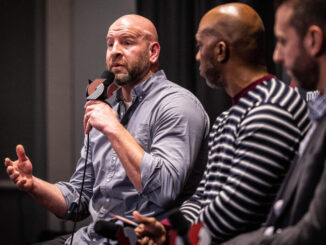
The year was 2017. THEY were once again sleeping on the Portland Trail Blazers.
The Blazers ended up with 48 wins and the third seed in the brutal Western Conference, shutting down critics and keyboard warriors alike. Until…
Jrue Holiday happened.
The Blazers went on to drop the series in 0-4 fashion, but the bad news was just beginning.
The offseason was just as bleh as the first round of the playoffs.
Now we’re just weeks away with more questions than answers as it pertains to the 2018-19 edition of Rip City Season. Jared Wright and Bryant Knox of Oregon Sports News are back with their in-depth Portland Trail Blazers 2017-18 Season Previews for each player.
Today, we take a look at the oft-maligned, and very rich, sixth man for the Blazers, Evan Turner.
2017-18 Recap
| Games | MPG | PPG | RPG | APG | FG% | 3PT% | FT% | PER |
| 79 | 25.7 | 8.2 | 3.1 | 2.2 | 45% | 32% | 85% | 9.9 |
I know plenty of folks in Rip City have been critical of Evan Turner; one look at my archive is enough to tell anyone that I’ve been one of the most critical. Looking through his stats, and comparing them to most of his historic norms, tells an interesting story about his 2017-18 season. It wasn’t outright good, it wasn’t completely awful (like some folks that don’t have Basketball Reference bookmarked on their phone might think), it was a mix of both.
Separating the sweetmeats from the offal in Turner’s stat lines is a chore. I got sick of it earlier in his Blazers tenure, but now that we’re entering year three of his onerous, odious contract, the end is in sight.
First, the good: Turner shot the ball better than he has in years, maybe ever, last season. His three-point percentage in 2017-18 was the highest it’s been since 2013, when he shot 36.5% from the arc. (Evan Turner was once a league-average three-point shooter. I swear I didn’t make this up.) As for his overall shooting, it’s never varied much through his eight-year career, but 45% is the high end of that variance. His free-throw shooting was a career-high, though he’s drawn very few fouls during his time in Portland.
His True Shooting Percentage was a career-high of 52%, taking into account all his field goals plus his free throws. Turner also cut back on his shot attempts, taking the fewest shots per game (7.3) since his rookie year. Though his poor outside shooting continues to be a big reason why the Blazers have stalled out in the postseason (and a big reason why many fans dislike his game), cutting back on his shot attempts helped him turn in an efficient shooting season, for Turner.
The Villain was a healthy Villain last year, too. After breaking his hand in 2016-17, Turner had no health-related issues; the Blazers, as a whole, were uncannily lucky in terms of injuries, unlike the rest of the Western Conference playoff field. That good injury luck was a huge reason why they were able to squeak into the third seed in the 2018 playoffs.
Now for the bad: among all the Portland rotation players, Turner had the worst defensive rating other than Zach Collins, a foul-happy rookie big man playing 15 minutes a night. Those gaffes can be forgiven from Collins; teenage centers are not bastions of rim protection in the NBA. For Turner, an eight-year veteran and the senior player in the rotation, bad defense is a mix of Turner getting roasted by the top perimeter player on the opposing team every night, and his just being not that great at defense in general. His average athleticism and length may be enough to do a serviceable job against secondary threats, but poor ET kept getting outclassed. If Portland coach Terry Stotts wasn’t using such a conservative defensive scheme, Turner’s stats might look even worse.
The Blazers finished eighth overall in defensive rating in the NBA, so Turner didn’t hurt them too badly. Getting him more help, or simply playing Mo Harkless more, could mitigate Turner’s defensive shortcomings, or save him from defending LeBron James, Kevin Durant, and James Harden 12 times a year.
What He Brings to the Table
The cheeky answer would be that the Villain brings nothing of value to the table for the Blazers, but Turner has an unusual game with some uses. He has some post moves (indeed, his turnaround jumper from 13 feet is probably the only reliable way he scores nowadays), he can run a secondary action if Damian Lillard can’t get a shot off or CJ McCollum dribbles to no avail, he has a bit of passing ability, he tries his hardest on defense…Turner has little moments here and there.
Turner does stuff. He just doesn’t move the needle much one way or another, which is confirmed by his Player Efficiency Rating of 9.9, the lowest of his career. As mentioned earlier, his defensive struggles didn’t stop Portland from earning their first top-10 defensive rating in the Lillard era. In theory, when he comes into the game, he is there to either stem the bleeding while one of the Blazers’ star guards rests, or help facilitate the offense when he plays in crunch time with Dame and CJ.
What usually happened was that Turner would defer too much to McCollum when Lillard sat, and would often stand around on the perimeter, nominally “guarded” by the worst defender on the team while Lillard or McCollum went one-on-three or two-on-four, depending on the play run.
Even though Turner shooting less is a good thing, I would like to see Stotts and Lillard look to use Turner to punish obvious mismatches more. Similar to what the Blazers did with Nurkic last year, I don’t believe the coaches put Turner in a position to succeed enough (him standing on the three-point line so much was painful to watch, and ruthlessly exploited in the playoffs), and the guards couldn’t help in that regard because all of them are score-first types. Lillard has learned to facilitate more, but it’s an acquired skill, not an instinctual one. He goes back to Dame Time when the chips are down, but teams are getting better at corralling him as his reputation grows.
Some of the issues with Turner are on Stotts, some on Lillard, and some are on Turner himself. For all the ways that he could become more of an asset to Portland, the fact remains that he’s a replacement-level NBA player that was drafted way too highly (he’s a former no. 2 overall pick) and is paid way too much. No matter how serviceable he is in some areas of the game, he’ll always bring those stigmas to the table.
Basically, if Dame is Kevin Johnsonwith a jump shot, and CJ is Midget Reggie Millerwith a much worse team, Evan Turner is definitely Tim Thomas: the epitome of replacement-level production, someone who could be exchanged for a guy making $10 million less than him without the Blazers missing a beat.
What to Expect in 2018-19
We can expect more of the same from ET this season, maybe with a little difference in efficiency or production. Hopefully, he can play the sixth-man role more this season, and not start so often; last year, he made 40 starts out of his 79 games played. That was a product of Stotts not trusting Harkless, and the wing options behind Turner and Mo being unproven or underwhelming.
We can also expect more frustration around Turner as a player in general. His contract is a sore spot now, and has stained General Manager Neil Olshey’s reputation here, as well as strained his relationship with the fans. Bryant and I are not immune to the antipathy towards Olshey, either; in our Google Doc spreadsheet where we organize this series and sort out who writes about who, we put “Evan Turner’s Future Expiring Contract” in the draft pool. That’s what he is now, a Future Expiring Contract that will turn into an Expiring Contract in summer 2019.
It’s a shame, for Turner is a nice guy and a class act. Most fans can’t differentiate between the model citizen and the grossly overpaid role player; that’s why they’re fans.
Portland doesn’t have any assets of real value, other than a first-round pick that will likely be somewhere between 12 and 20 this summer (unless the Blazers drastically overperform or underwhelm) and McCollum. CJ makes enough money that he could be swapped straight-up for most guys in the NBA, but a team looking for a bit of cap relief might welcome Turner’s deal in a large, hypothetical trade next summer, or even in January if Olshey does a complete 180 on his No Trade CJ stance (or owner Paul Allen orders him to make a trade).
All that noise is just speculation and wishful thinking, though. Right now, the Trail Blazers are sitting on a roster that doesn’t have a high ceiling, but has a high floor. The only influence Evan Turner has on the fortunes of his team, however, is with his bloated contract. Another year being saddled with the worst free-agent signing in Blazer history awaits. Yay.
Check out the earlier parts of this series:




